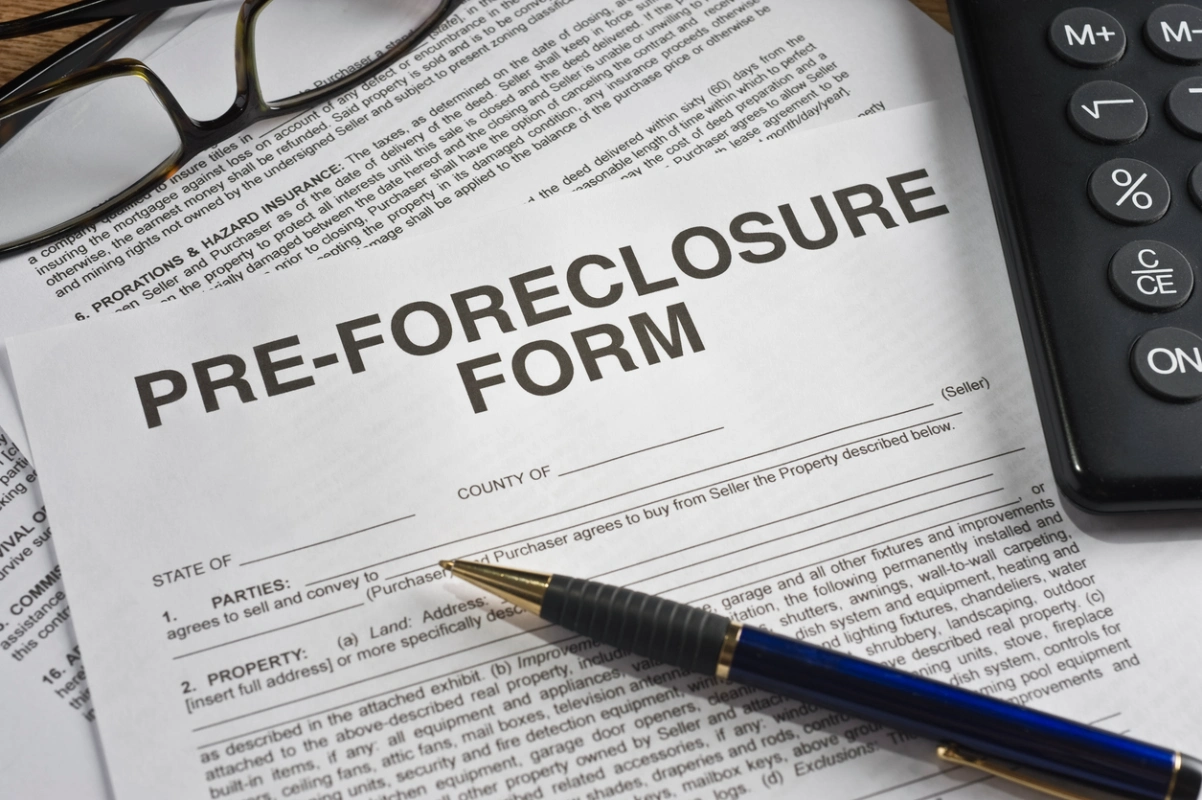
If you are in California and need a pre-foreclosure or foreclosure defense lawyer, Estavillo Law Group is here to help. With years of experience helping homeowners across the San Francisco Bay area get out of pre-foreclosure, our team is here to find you the best option to keep your home. Book an appointment with our law firm to get the guidance you deserve.
In the meantime, if you still have questions about pre-foreclosure, what it is, and why it happens, this article will give you all those answers and more.
If you own a home, it is likely you’ve heard the term foreclosure before. This is when a homeowner defaults on their mortgage, thereby breaking their agreement and forcing the lender to begin the sale of property.
Before foreclosure, however, there is an interim period during which the homeowner has the opportunity to save their house. This is known as pre-foreclosure.
So, what is pre-foreclosure, then? And what steps are required to ensure you and your home are protected against it? While it may seem daunting, this article will answer all your questions and more.
What does pre-foreclosure mean? And why am I experiencing it? While these questions will be answered, it is important to remember that the cause of pre-foreclosure is specific to each homeowner. This is why getting legal input for pre-foreclosure is important. Schedule a consultation with one of our pre-foreclosure lawyers and receive the crucial legal advice you deserve from trusted and experienced professionals. Contact Estavillo Law Group today to book a consultation with one of our pre-foreclosure and foreclosure defense lawyers.
Pre-Foreclosure Explained
What does pre-foreclosure mean? As the name suggests, pre-foreclosure is the period before foreclosure, during which the lender, typically the bank, files a notice of default with the county recorder’s office for missed payments. This notice is then sent to the homeowner (the borrower), informing them of missed mortgage payments.
This means that the homeowner has broken the terms of their mortgage agreement but has yet to forfeit ownership of the property. In the San Francisco Bay area, a notice is typically filed after 90 days of missed payments.
Pre-foreclosure begins once the notice of default is received. While pre-foreclosure varies per state, typically, a notice of default is typically sent after a borrower fails to make three consecutive monthly payments.
Pre-foreclosure is the first legal step toward foreclosure and should not be taken lightly.
Knowledge and preparedness are a homeowner’s best tools against pre-foreclosure. Therefore, it is important to understand what it is, why it happens, and the steps it involves to protect yourself and your home. Getting legal advice from a reputable firm will be a great boon in helping you understand pre-foreclosure and how to get out of it.
Understanding the Steps in Foreclosure
Pre-foreclosure must be contextualized within the foreclosure process because it is, essentially, the first legal step a lender can take against a homeowner.
Let’s take a closer look at the steps of foreclosure:
- A homeowner misses mortgage payments. The first step in the foreclosure process starts with the homeowner missing, typically, three consecutive mortgage payments, thereby breaking their loan agreement.
- Lender issues notice of default. In response to the missed payments, the lender will send a notice of default to the homeowner, informing them of the issue and that legal action may be taken if it is not rectified. The homeowner has not lost their property at this time. Notices are intended as warnings and usually include guidance to avoid foreclosure.
- Pre-foreclosure begins. Once the notice of default has been received, the homeowner enters into pre-foreclosure. This period ranges in duration depending on the state and/or the mortgage agreement; however, it is usually one to four months. During this time, the homeowner has the opportunity to repay missed payments, sell their property to recoup losses or challenge the pre-forclosure notice.
- Foreclosure — notice of property sale. If the homeowner cannot resolve the default, either through repaying or successfully challenging it, their home enters foreclosure. This means the bank sells your property at auction.
- Foreclosure — bank repossession. If the house is not sold during the auction, the lender may claim ownership of the property and sell it through a traditional real estate agent or a property listing.
These are the five steps in the foreclosure journey. So, what can you do to protect your home against each, but particularly against step two?
Steps to Follow to Protect Your Home
One of the good things about pre-foreclosure is that it is the step before foreclosure, meaning the homeowner has not lost their property and, in fact, has the opportunity to retain it. Let’s look at some options you have to protect your home.
If you have not yet received a notice of default but know that you will have issues making your mortgage payments in the future, you can seek loan forbearance. This is the short-term suspension of your mortgage payments due to loss of income and/or a temporary inability to make proper payments. Only the lender can grant a borrower loan forbearance. Ideally, this option is sought before a missed payment. If you are thinking about requesting loan forbearance but are unsure how to do so, speaking with a lawyer can be helpful and informative.
If you have already received a notice of default, it is strongly suggested that you contact a foreclosure lawyer. A foreclosure lawyer can help you determine your best options, represent you in court, and assist with loan renegotiations. Book an appointment with an Estavillo Law Group lawyer today to get all the answers you need and more.
How to Stop a Pre-Foreclosure in California
Knowledge is one of your best weapons against pre-foreclosure. So far, we’ve defined pre-foreclosure, meaning the time frame immediately following a notice of default that informs a homeowner of their failure to comply with their mortgage agreement. We’ve also explained how, during pre-foreclosure, the homeowner remains in possession of the property and is given the opportunity to repay their outstanding balances.
Now, let’s talk about how to stop pre-foreclosure.
Unlike foreclosure, pre-foreclosure is not permanent. This means there are things you can do to stop it. While speaking with a lawyer to develop a strong strategy is the safest way to stop pre-foreclosure, it is important you familiarize yourself with all the options available:
- Repay outstanding payments. There are myriad reasons why homeowners miss payments, including forgetfulness. It happens to the best of us. If you have the financial means to repay your outstanding mortgage payments, do so, as it is the quickest way to resolve the looming threat of foreclosure.
- Challenge the notice of default. Pre-foreclosure laws are usually strict, and lenders can make mistakes. Therefore, depending on state laws and/or the mortgage terms, the homeowner may be able to challenge the notice. It is in your best interest to consult an attorney if you are interested in contesting a notice of default.
- Modify your mortgage. Homeowners can contact their lender to request a loan modification or restructuring, including extending the loan duration, reducing the monthly payment amount, and/or changing the interest rate. Loan modifications are best done before a notice of default has been issued, but can still be undertaken even if a notice has been received. Lenders are not obligated to agree to modifications or restructuring; therefore, it is a good idea to consult an attorney to help with your request.
- Refinance your loan. Homeowners have the option of paying off their outstanding loan with a new loan. The new loan can be issued from the current mortgage lender or a different one. There are advantages to refinancing your loan with your current mortgage provider, like pre-existing knowledge of your financial background.
- Selling your property. When it comes to selling your property, there are two options for homeowners:
- Short sale. When a homeowner sells their pre-foreclosure home below the mortgage value. The homeowner does lose their house, but the mortgage will be considered repaid, even if the bid is less than the mortgage value. An important stipulation for a short sale is that the lender must be involved, including giving the final approval to accept an offer. If the lender rejects an offer, then the homeowner cannot sell. This option can impact a homeowner’s credit score but is often still better than foreclosure.
- Cash sale. The homeowner can sell their property to a third party for cash. This differs from a short sale in that it does not affect your credit score and allows for more control over the price of the sale.
Taking Action Against Pre-Foreclosure
If you are facing pre-foreclosure on your primary residence and don’t know what to do, contact an experienced foreclosure attorney, at Estavillo Law Group are here to help.
Now that you know what pre-foreclosure is, why it occurs, and some of the options to stop it, you may be wondering: Where should I go from here?
Consult a reputable and seasoned lawyer who can help you build a strategy tailored to your specific circumstance. Estavillo Law Group is here to provide you with tailored, thoughtful advice and guidance to best tackle pre-foreclosure.
We at Estavillo Law Group understand that knowledge and taking action early is the key to successfully avoiding pre-foreclosure; therefore, the more you can learn about it, including its relevance to foreclosure, and do something about it, the better. Your first step is to speak with legal counsel. Our firm has a 90% success rate of stopping imminent foreclosure. Schedule a consultation with one of our attorneys today to get the information you need.
Pre-foreclosure can feel daunting. But with the right knowledge and plan of action, it does not have to be. Whether you decide to contact us or not, we sincerely hope you feel better equipped to handle pre-foreclosure if it arises for you.


